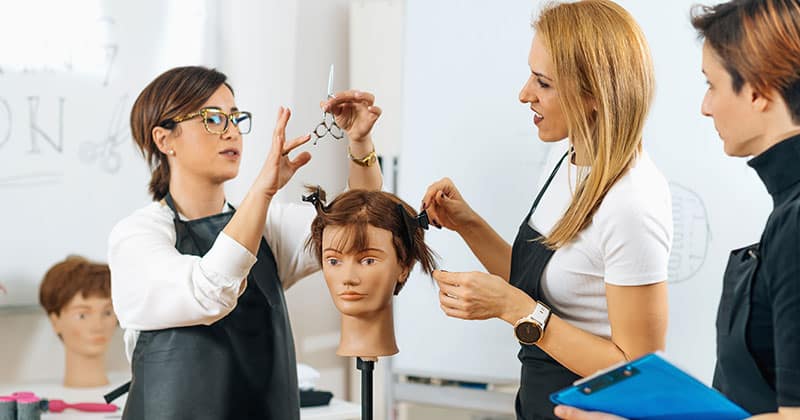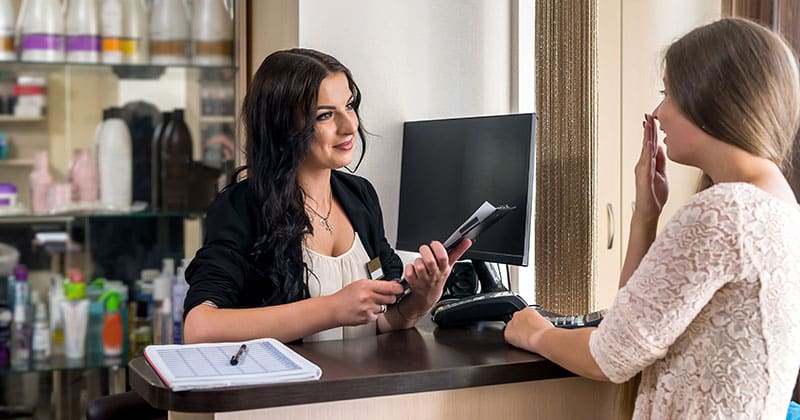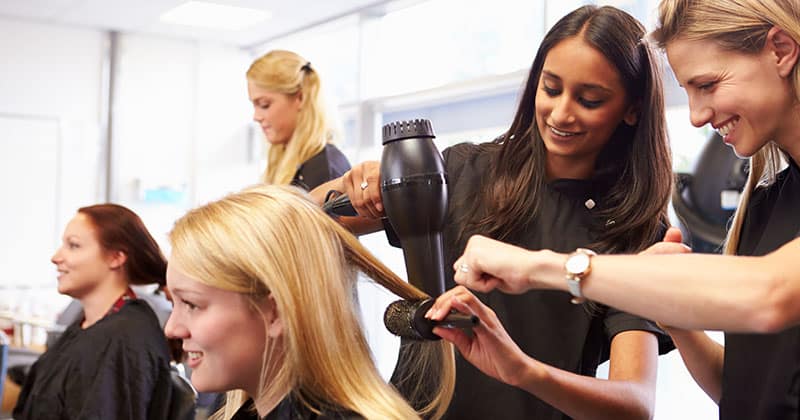Staff training is key to boosting customer numbers and your bank account if you own or manage a salon. A fully trained salon staff offers more desirable skills as well as a professional and relaxing environment that entices customers and justifies higher pricing.
We’ll show you how salon staff training improves customer satisfaction. And how the improved experience, in turn, increases revenue and puts your business ahead of the competition.
Explore Training Ideas
Elevating the Salon Guest Experience
Customer retention is vital to salon business stability and growth. Consistent customers are the backbone of your revenue stream.
When a customer is happy, they’re also more likely to recommend your services. This free word-of-mouth advertising brings in new customers—another boost to your revenue.
Above anything else, your salon is a business dependent on creating a positive customer experience.
A disappointing dinner out or a poor lawn mowing job doesn’t leave the client with the lasting effects of a bad haircut or brow waxing. But your customer’s opinion of their experience isn’t just based on their results.
A good experience starts the moment they enter the salon and ends when they walk out the door. Every staff interaction, from “Hello” to “When should we schedule your next appointment?” must meet their expectations.
A well-trained staff is an essential part of retaining your customers. The right training shows them how to help customers relax and feel welcome. And, of course, it enhances technical proficiency, giving visitors their desired results.

Keeping Up with Salon Industry Trends
One prime element of salon staff training is staying current on cutting-edge industry trends and techniques.
Hair salon staff should be proficient at executing the latest cut and color trends. Customers will expect them, whether they bring a magazine photo to imitate or mention a celebrity look they admire.
Nail trends are constantly changing, too. Trends in length, colors, art, and artificial nail applications update frequently. While some clients may want a classic mani, others want to look like they’re right out of Vogue or Instyle.
Social media influencers are playing an increasingly large role in nail styling trends. More customers are bringing inspiration photos taken straight from their favorite Insta. If you aren’t on top of the latest trendy services taking over socials, you won’t have the necessary inventory or talent to complete them, and customers will go elsewhere.
A chef builds on basic food preparation to incorporate new recipes for customers. Likewise, your staff should use classic salon techniques as a foundation for trends.
Some current salon technical trends today include:
- Hybrid brows—microblading plus natural
- Wet look lashes
- Choppy shag haircuts
- New deep shades in red hair color
- Casual hair parting for men
- Shorter men’s beards
- Shiny metallic nails
- Facial self-tanning in place of foundation
- Natural products in waxing
Updating techniques for aesthetics is just one aspect of staying current with trends. The other involves things like customer service and technology. Examples might be:
- Providing concierge-style assistance at the front desk
- Offering a hand or scalp massage to waiting customers
- Serving cappuccino or champagne between services
- Using digital appointment scheduling and online payment
- Utilizing the latest in salon chairs or spray tanning booths
Your staff must also be trained to leverage these extras to keep customers happy.
Building Trust and Credibility
Another important reason to have adequately trained salon staff is to establish client trust. They know when an employee is unsure or flustered. It makes them wonder if something will go wrong with their services.
Think about your own preferences in service industries. A plumber comes to your house but doesn’t seem to know how to unclog a sink drain. How much confidence would you have in them fixing your problem? Would you hire them again?
The same goes for your salon. You want to develop a reputation for being the most competent and knowledgeable in your niche.
Additionally, you want your staff to behave in a completely professional manner. You can have the most technically proficient staff in the world. But if they behave unprofessionally around customers, it won’t matter.
FROM ONE OF OUR PARTNERS: How to Manage Salon Staff Well
Behaviors like these tend to turn clients off:
- Gossiping about other staff or customers
- Taking personal calls while with clients
- Smelling like cigarette or marijuana smoke
- Chewing gum or eating while serving visitors
- Rushing customers when moving them between stations
- Ignoring visitors when they enter the salon
- Not helping customers find changing rooms or smocks
- Dressing in a revealing or provocative way
- Making visitors feel bad about their “before” appearance
- Pushing customers into trends they don’t want
- Not thanking clients for their business or tip
Review your policies about professionalism in a group meeting or put them in writing in a staff handbook. Also, walk through the customer’s journey from beginning to end. See where you might be dropping the ball on serving them.
When staff behave professionally, customers feel comfortable. And that helps you stand ahead of the competition.
We’re still waiting for the final numbers on salon market share from 2023. However, it was previously predicted that the haircare market alone would increase from $69 billion to $87 billion in less than a decade.
While growth in the salon industry is fantastic, it comes with a caveat. There will be more salons for you to compete with. That means you need to keep upping your game to stay on top of the market.
RELATED ARTICLE: 5 Tips for Smashing Your Hair Salon Recruitment Goals

Maximizing Salon Sales Opportunities
There are a variety of ways your salon can increase its revenue. Naturally, bringing in new customers while retaining existing ones is a priority. But you can also boost sales through staff expertise. How?
A well-trained staff knows how to upsell and cross-sell. For instance, imagine that a client comes in for a quick haircut. During her initial consultation, she mentions she is unhappy with her hair color and worrisome thinning.
There’s an opportunity to ask if she’d like a color change with her cut. A skilled stylist could suggest some flattering color options on the spot. They can capitalize on their guest’s desire to look and feel better.
It’s especially great if the stylist can add the second service at the same appointment. The client is more likely to add treatments if they don’t pose extra inconvenience.
The client’s thinning hair could also be addressed. A staff member who is knowledgeable about the products you sell could recommend a better shampoo and conditioner for fine or thin hair. Or perhaps a hair mask to promote growth would be a solution.
Maybe, as she’s chatting, the client also mentions being frustrated with doing her own brows. The stylist could mention they have a brow professional available every Thursday. The customer could then add a brow sculpting to their next hair appointment.
Another option is to have makeup consultations available several days per week. This type of cross-selling works not only with hair salons but with facials, brows, and tanning, too.
The key is to have a staff member trained to offer this at the right moment. The customer’s trigger is their initial service. They may willingly buy other services as part of a more comprehensive makeover.
Investing in Salon Employee Growth and Retention
Speaking of growth, employees and contractors in your salon want to improve their skills, too. Learning new skills and being at the forefront of industry developments helps keep salon workers motivated.
Motivation is a key ingredient of job satisfaction. If the people in your salon don’t find their jobs rewarding, they will likely go elsewhere.
Did you know that staff retention was the second most urgent business problem reported by hair salons in 2023?
In the salon business, employee loss is particularly detrimental. Stylists and estheticians often take their best clients with them. When they do, you lose regulars and the income they bring in.
You’ve probably experienced this from the other side yourself. Maybe your favorite mechanic left your automotive garage. Or your doctor left your medical practice. Did you follow them to a new location?
Implementing an online training program, like SalonBiz Academy, allows employees to attend training sessions on their own schedule and at their own pace. By offering role-based training like this, you can keep coveted employees and contractors working for you. They won’t have to go elsewhere or pay for training. And you won’t have to invest time and money in getting replacement staff up to speed either.
Guess what the number one problem was for hair salon owners last year? Recruitment of both W2 employees and stylists renting chairs.
When your salon acquires a reputation for being ahead of the curve with staff training, recruitment also improves. You can attract top performers who bring their client list to your salon—a great way to grow business.
FROM ONE OF OUR PARTNERS: Staff Incentives 101: How to Keep Your Employees Motivated and Reduce Turnover

5 Ideas to Implement in Your Salon Staff Training Right Away
Now you know the immense benefits of starting a salon staff training program. The good news is that you don’t have to wait to get going. Here are six ideas you can begin working on right now:
- Decide What Your Training Goals Are First
Base them on your business priorities and where you’ll get the best return on investment. Most salons have a mix of needs, including basics of customer service and technical skills. Build your training program around your unique goals. Not sure what your staff needs or wants? Ask them!
- Use SMART Goals
That means specific, measurable, achievable, relevant, and time-bound. Don’t use vague goals, like “Get better at beard trimming.” Be more precise. Say, “Have all new stylists able to trim beards independently by May 1 to meet summer wedding season demands.”
- Put Your Goals and Training Milestones on Paper
Make a calendar. Schedule six months to a year of training sessions that fit within your larger goal framework. Give staff a copy of the schedule so you can ensure their attendance.
- Keep an Ongoing List of Training Ideas
As you work through each month, gather client suggestions or feedback. You’ll see where you have gaps. You may also notice places where novice workers feel unsure. Or a new trend may surface that your salon needs to get on board with.
- Develop a Staff Mentorship Program
Pair new workers with experienced ones. This partnership lets you conduct an informal training program alongside your more formal plan.
This is similar to how medical residents learn procedures. First, they watch an experienced physician. Then, they work under supervision until they master the skill.
Don’t forget to include training on salon management software.
Salon management software simplifies administrative tasks, giving staff more time to focus on customers. Choose software like SalonBiz, and you can take advantage of SalonBiz Academy.
SalonBiz Academy streamlines training by creating different training paths by role. Your training program can be standardized while letting everyone work independently.
RELATED ARTICLE: 7 Steps for Designing a Salon Training Program





